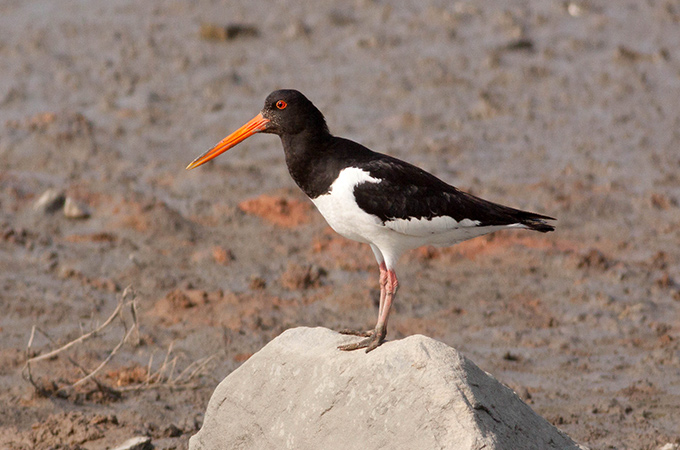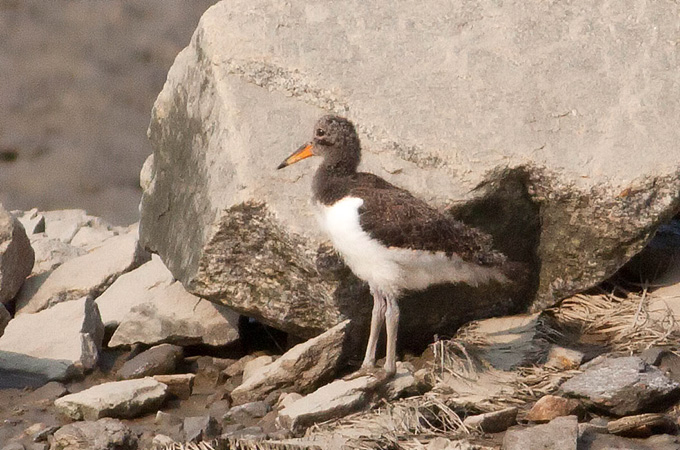 | E-mail to Birds Korea |
 | KWBS |
in the Region
 | The Oriental Bird Club |
 | BirdLife International (Asia) |
June
Often hot (temperatures up to 30°C or more inland) and humid, with very heavy rains some years by mid-month.
By early June, Yellow and the rare Schrenk’s Bittern are breeding in the least disturbed reed-beds, and Watercock give their (slightly comical) gulping calls in a few rice-field areas. Nesting activity in Black-faced Spoonbill and Chinese Egret colonies peaks, and forest nesters are still vocal, especially in the first half of the month. At Gwangneung, typical species include 4 species of woodpecker, Ruddy Kingfisher, Yellow-rumped Flycatcher and Mandarin Duck, while on the south coast at Geoje Island Pale Thrush, Blue-and-white Flycatcher and Yellow-throated Bunting predominate. Black Woodpigeon nest on Gageo and other islands and Styan’s Grasshopper Warbler are widespread on small islets. Although not usually considered a month for migration, June has nevertheless provided some national firsts in recent years, with a Lesser Coucal in 2005, Malayan Night Heron in 2006, and a Roseate Tern at the Nakdong estuary in 2008.
(The following records are a compilation of our own sightings and records sent in by other observers. As well as being posted on the Birds Korea website(s), selected records are also forwarded to other Korean-language birding websites; records of threatened species are arranged and forwarded to Birdlife International and national authorities when appropriate; flag images and records are passed to bodies responsible for their coordination throughout the flyway; and all records sent to us are used to compile annual reports and to support the evolving understanding of the status of many of Korea’s birds.)
Gimhae, June 30
Despite the rain, I had an early start on Saturday. Although it wasn’t the safest condition for a bike ride, I couldn’t resist continuing my search for crakes down at Haebancheon. Geared up in my rain jacket, I slowly followed the stream through the rice fields. There were Oriental Reed Warblers showing very well on the reeds. Just two weeks ago, I could only hear them, but now it is obvious that something has changed. The early morning brought many Great Egret, Cattle Egret, and a few Striated Heron to the sky. Every so often I came across a Common Moorhen feeding along the banks of green healthy vegetation. Most of the stream lined with some of the typical wetland plant species such as silver grass, common reeds, yellow floating hearts, and water chestnuts. It is a good place to scan the water’s edge and watch for birds flying low to the water. Making a stop near a muddy-edged garden that was next to a rice field across from the stream, I found a Moorhen with more than three chicks. Suddenly a Yellow Bittern flew by and landed on some reeds. I was surprised to see it climb up and down, looking much smaller and lighter than I had remembered. As I watched, I became even more delighted to hear what sounded very much like a Painted Snipe. There were no birds in the lone nearby tree, and this “song” was coming from the field/garden area. I failed to find it but then heard another singing from a different direction. I certainly hope to see them at different conditions.
Showers throughout the morning were consistent but there was a break in the clouds in the early part of afternoon. That is when Shane and Yoli Park joined me. Together we cruised the edge of the stream. At one spot on the stream, just before it connected with another tributary, we found three Black-crowned Night Herons, a Striated Heron, more Oriental Reed Warblers, a Spot-billed Duck, a male Eurasian Teal, some Barn Swallows, some White-cheeked Starlings, some Vinous-throated Parrotbills, and more than 5 Yellow Bitterns along these reedy banks or in flight low to the water moving upstream. In the sky, we also spotted a Eurasian Hobby feeding on insects. Although the showers didn’t let up, it turned out to be a really great morning, and excited to say that it seems like Gimhae has a lot of room for discovery.
Gwahrim Josuji, June 30
Here, I noted breeding birds such as Common Moorhen, Yellow-throated Bunting, Jay (apparently attempting to catch fledglings of Vinous-throated Parrotbills) and at dusk a calling Brown Hawk Owl/ Northern Boobok. There was also a Striated Heron family. The parents fished busily while the fledgling hid clumsily in nearby trees.
Gwahrim Josuji, June 30
Cooling rains finally arrived on the 29th, bringing the usual overcast summer weather (terrible for photography). Gwahrim Josuji is excessively used for recreational fishing (including by 8 Great Cormorant) and all waterside vegetation has been removed for fishing platforms. However the inflowing stream is still nicely swampy (although heavily disturbed).

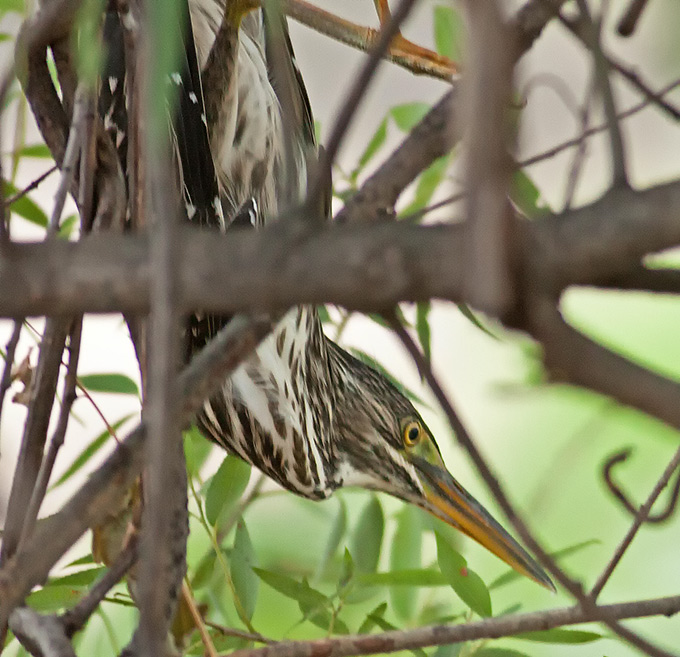
Goseong, June 28
I went early to a temple site and within minutes, at 7:25am, the first Ruddy Kingfisher I have seen in Korea wheeled up to an overhanging branch nearby, as if to check out the intruder. He sloped off downstream and immediately I saw an Asian Brown Flycatcher perched high in a tree. Very soon after, a Common Kingfisher appeared by the stream in the same location, but didn’t stay long. Things settled down after this, though there was abundant bird-life, including a passing Chinese Sparrowhawk, Pale Thrushes, Japanese Pygmy Woodpeckers and a juvenile White-backed Woodpecker. I left after two and a half hours, seeing an Asian Stubtail as I was about to move off, as well as some colourful Dark-spotted Frogs (Rana nigromaculata). No more Ruddy Kingfishers (no calling even), but one can’t ask for too much!
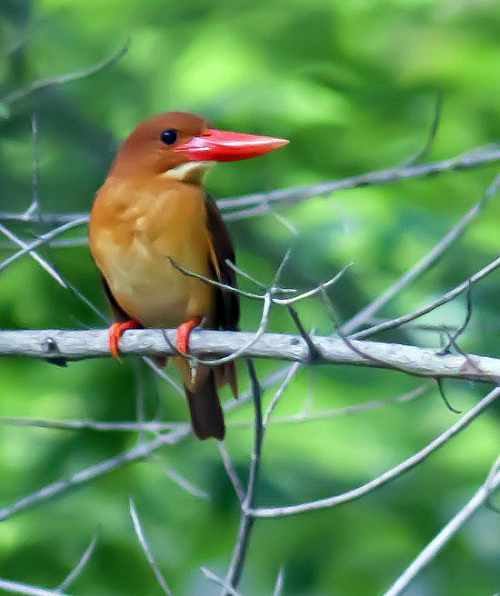
Yeongjong, Cheorwon, Geoje, June 17-24
Although mid-late June is NOT the best time for birding in the ROK, an enjoyable eight days in the field took us to a broad range of habitats and included a good number of surprises! Moving from north to west to southeast, we birded Yeongjong and Imjingak (June 17th), Cheorwon and the Han River (June 18th), Namhansan and Seosan Lake A (June 19th), Weiyeon Island (June 20th-21st), open sea off Heuksan Island (June 22nd), Mokpo Namhang Urban Wetland and Hwaum Temple (June 23rd) and Goseong and Geoje (June 24th). In total, we recorded 122 species, including nine globally threatened or near-threatened regional endemics, and an excellent range of summer (and some typical winter!) species. A few of the highlights follow (with their global status from BirdLife International 2012, and their national status from Moores & Park 2009, the Birds Korea Checklist – see sidebar at http://www.birdskorea.org/Birds/Checklist/BK-CL-Checklist-Aug-2009.shtml):
Gadwall W3. One at Seosan on June 19th. Rarely, if ever, previously recorded in mid-summer in the ROK.
Falcated Duck (NT) W3, SV2. One at Yeongjong on 17th and a flock of 16 at Seosan on 19th. There are only a few mid-summer records. The Seosan flock is probably the largest mid-summer concentration recorded to date in the ROK.
Northern Shoveler W3. One at Seosan on June 19th is apparently the first mid-summer record in the ROK known to Birds Korea.
Baikal Teal W1, SV2. One presumed bird in eclipse seen at longish-range at Seosan on June 19th.
Common Pochard P/W2. Two were at Yeongjong on June 17th and one was at Seosan on 19th.
Short-tailed Shearwater P5. Three were seen from the ferry to Weiyeon Island on June 20th, and one was seen near Heuksan Island on 22nd.
Flesh-footed Shearwater P5. Three were seen with Streaked Shearwater near Heuksan Island on June 22nd.
Swinhoe’s Storm Petrel (NT) S3. Two or more likely three were seen at sea near Heuksan Island on June 22nd.
Eurasian Spoonbill W4, SV1. At least seven together at Seosan on June 19th.
Black-faced Spoonbill (EN) S4, W5. At least 14 at Yeongjong on June 17th and 8 at Seosan on 19th.
Von Shrenck’s Bittern S4. Two males seen (NM only) at Cheorwon on June 18th.
Chinese Egret (VU) S4, WV2. At least four or five were at Yeongjong on June 17th and eight at Seosan on June 19th.
Booted Eagle V2. One presumed pale morph on June 17th close to the international airport at Incheon. For most birders visiting the ROK, the first species is usually Eurasian Magpie or Black-tailed Gull. Not this time. Within a kilometre or so of the terminal a largish raptor was called out from the moving car. Expecting it to be a Crested Honey Buzzard, mild excitement increased rapidly as the spiralling raptor looked too heavy-set, short-necked and round-headed. It was also largely white below, though with striking black-looking secondaries and primaries. Prolonged views through binoculars over the next 2-3 minutes confirmed that there was some hint of a pale blaze on the inner primaries and some suffuse-wash on the head and upper breast. As it spiralled against a glaring blue-white sky, pale brown upperwing coverts also contrasted strongly with darker flight feathers, and there was a hint of white “headlights” on the forewing. Although it looked surprisingly short-tailed, only one species shows such a distinctive plumage: Booted Eagle (photographed twice before in the ROK, with a handful of further “probables” – mostly of dark morphs). Was this a late migrant, or might it instead be over-summering in the area?
Ruddy-breasted Crake S5. Presumably much overlooked, two were watched well feeding in a rice-field at Imjingak on June 17th.
Watercock P/S4. Excellent views were enjoyed of a (second calendar year) male chasing and “gulping” to a female in Cheorwon on June 18th. Another male was also heard and seen well at Seosan on 19th.

Black-tailed Godwit (NT) P2, WV2. A flock of 35 were at Seosan on June 19th: an apparently exceptional concentration in the mid-summer.
Far Eastern Curlew (VU) P2, S3, WV1. Seven at Yoengjong on June 17th and 25 at Seosan on 19th.
Common Redshank P4, S5, WV2. Two birds showed mobbing behaviour, suggesting (continuing) local breeding, at Yeongjong on June 17th.
Saunders’s Gull (VU) P/W3, S4. 35+ were on the southern tidal-flat at Yeongjong on June 17th.
Crested Murrelet (VU) V1. One of the main highlights of the trip – with three found “just off the boat” a little north of Heuksan on June 22nd. This chance encounter appeared to be of one or perhaps two adults accompanying a young of the year, presumably out to sea away from their breeding colony While BS took some video (which we hope to post later), NM could only manage a series of handheld shots through a Nikon 55mm lens – where are big camera lenses when they are needed? Although considered to be a rare bird in Korea (cf. the 2009 Birds Korea Checklist), more recent survey work by the Korea National Parks Service and by researchers in Jeju and Shinan County suggest that we presently have a breeding population of several hundred pairs of this species in the ROK – rendering the old name of “Japanese Murrelet” pretty obsolete!
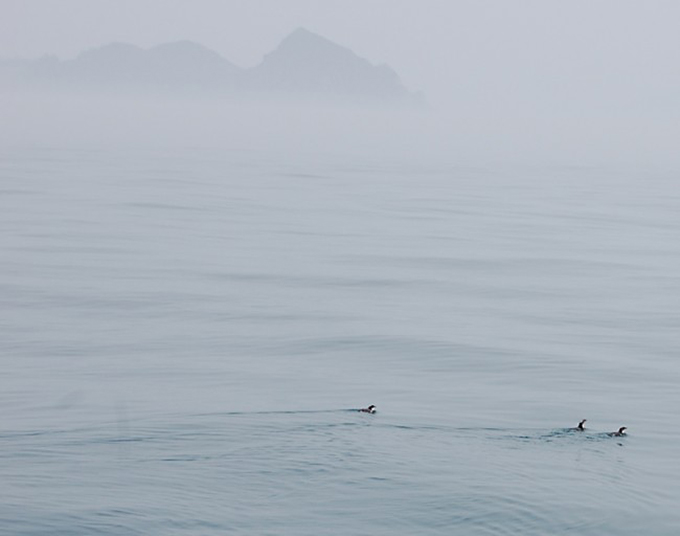
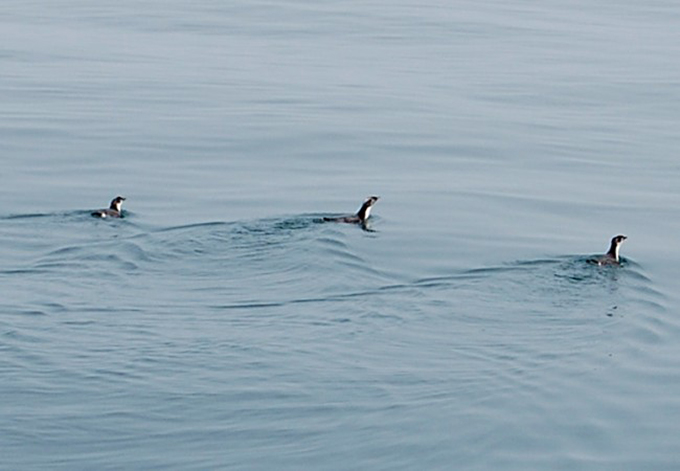
Ruddy Kingfisher S4. Heard in five different localities (with a maximum of 10 heard in Cheorwon trilling during the morning of June 18th) but glimpsed only a couple of times…
Black Woodpecker R3. An unexpected close-up encounter with two of three recorded on an island in the Han River on June 18th.
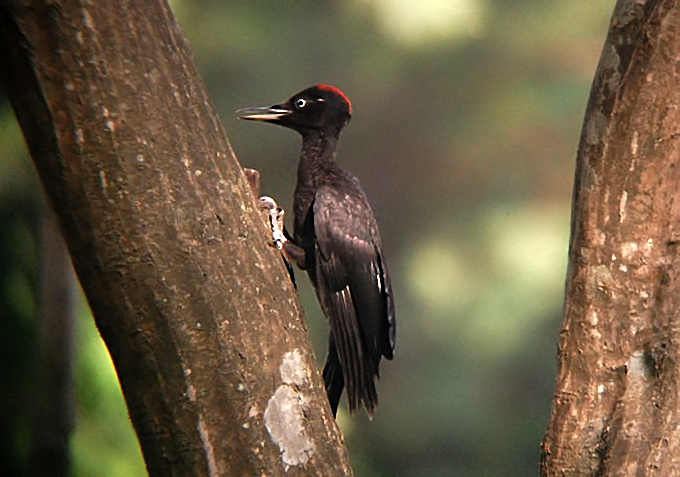
Fairy Pitta (VU) P/S4. During the only day of inclement weather, one was heard on Geoje on June 24th.
Black Paradise Flycatcher (NT) P/S4. A male and female were glimpsed several times on Weiyeon Island on June 20th-21st, and a male was seen briefly by JL on Geoje on 24th.
Pale-legged Leaf Warbler P3. One was heard briefly in song at Namhansan (NM only) on June 19th. The species breeds commonly in parts of the DPRK but appears to be seldom (if ever?) reported during the mid-summer in the ROK.
Red-billed Starling P/W4, S5. One seen briefly from the moving car as it fed next to the road on June 17th (less than 1km after the encounter with the eagle) was the second species noted during the trip!
Asian Brown Flycatcher P2, S4. A fresh juvenile (with extensive white-tipping on the upperparts) and an adult were seen at Goseong on June 24th, clearly indicating local breeding. Park (2002) provides few records of breeding in the ROK (all in more northern provinces), though there have apparently also been some reports of breeding in southern provinces in recent years. It appears that the breeding range of this species, which breeds as close to the ROK as Tsushima/Teima Do and probably much of the DPRK, now includes much of the Korean Peninsula.
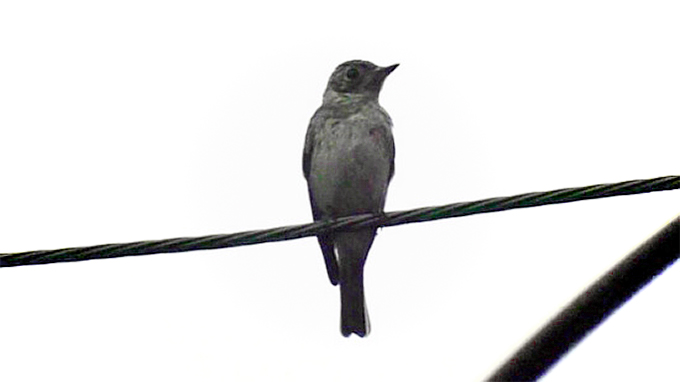
Narcissus Flycatcher P4. A bird recorded calling and heard singing (and seen only briefly in silhouette) on Geoje on June 24th is believed to be of this species. A follow-up visit in better weather is required to confirm (sub-) specific identify. Narcissina breeds in Kyushu (and perhaps as close as Tsushima/Teima Do according to Brazil’s Birds of Japan published in 1991) but there are very few previous mid-June records in the ROK (perhaps only two – both times in mid-June on Jeju, in 1979 and 1982, according to Park’s 2002 ROK ornithological review) . It has, however, also been recorded at least once in mid-June in the DPRK (one on June 12th 1949 in Gangwon Province according to Tomek in 2002).
Gaesu Josuji, Siheung, June 23
At Gaesu Joseuji on June 23rd, a very low water level and much human disturbance. Best, a close fly-by Oriental Scops Owl just after sunset, a brief calling Yellow Bittern, a Mongolian Gull and Eurasian Kestrel. At nearby Bucheon on the 21st, I had amazing close views of a large bat pursuing moths. The size of a pigeon, and with relatively cumbersome, fluttering flight, it seems to have probably been a Birdlike Noctule Nyctalus aviator.
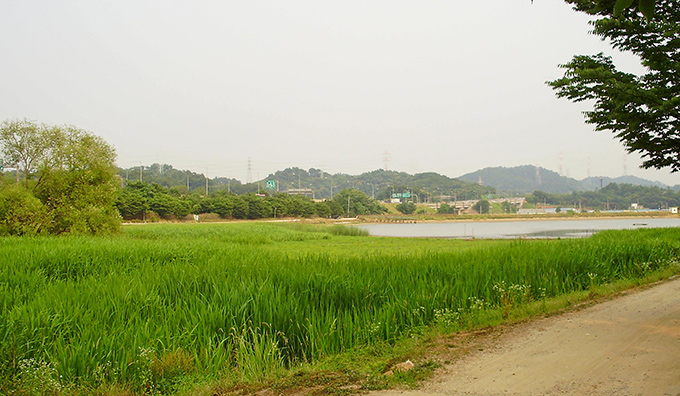
Yongjeong Island, June 17
At Yongjeong Island my quest for a photographable crake continued. Once again, a Ruddy-breasted Crake was heard to trill briefly at YongYuDo from the usual spot. Also of note, a Red-billed Starling in amongst a flock of 85 White-cheeked Starling. On the saltpans, two (presumably breeding) Kentish Plover in amongst the many Little Ringed Plover. Other sights included eg a Chinese Egret, White Wagtail, Eastern Carrion Crow, singing Grey-backed Thrush and a Striated Heron.
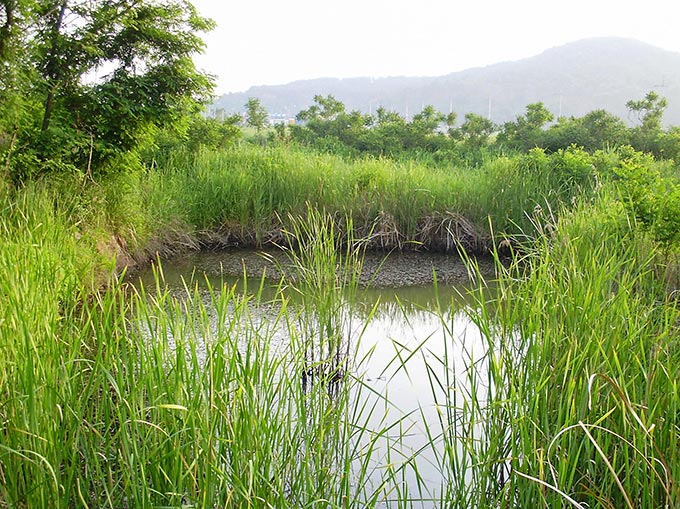
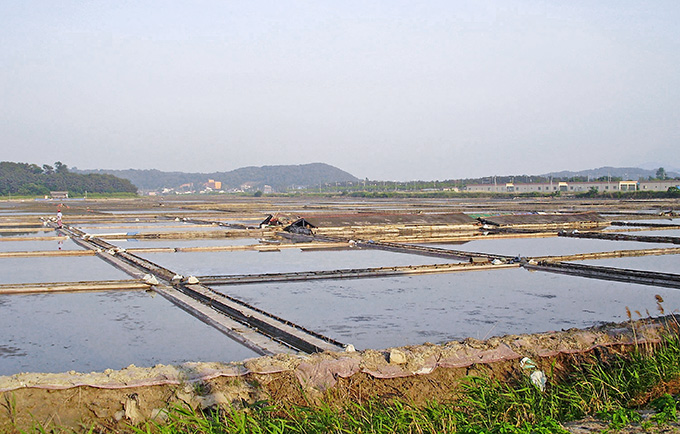
Uiwang, June 17
My first visit to the Uiwang reservoir in more than 2 months revealed dramatically reduced water content due to lack of rain. A leisurely walk along the southern bank and sometimes on the dried out parts of the lake revealed plenty of Great (~20), Intermediate (2) and Little (~12) Egrets. Other birds of note included Great Cormorants (~5), Little Ringed Plovers (4), a pair of Mandarin Ducks, a Black Crowned Night Heron, Grey Heron (~10), a Mongolian Gull, a Common Kingfisher and a Common Kestrel. A closer look at the trees on the western shore of the lake revealed a pair of Great Spotted Woodpeckers, a few Black Naped Orioles and a Eurasian Cuckoo.
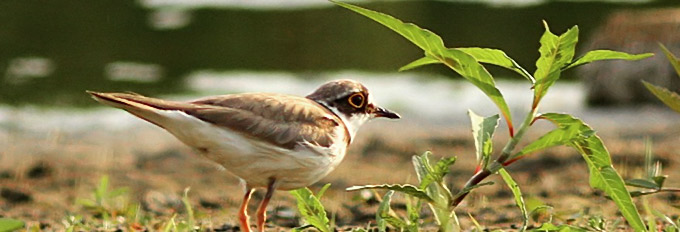
Geomam, June 16
I spotted some tempting habitat in Incheon from the train (months ago), which I decided to investigate on June 16. “Geomam swamp” consists of a massive reedbed (c.15ha), adjacent rice paddies, and thickly overgrown water channels. It is rare to find such undeveloped remnants, and this place has potential for future visits.
Of interest here today, at least two trilling Ruddy-breasted Crake towards sunset, literally yards away in thick vegetation, and an attractive Chinese Pond Heron.
For the record, I also found here a nest of Hobby, tracks of Korean Water Deer, and others including Dollarbird, Barn Swallow, Great Cormorant, Eurasian Cuckoo, Oriental Turtle Dove, Japanese Pygmy and Greater Spotted Woodpecker, Black-naped Orioles, Grey-capped Greenfinch, Long-tailed Tit, Brown-eared Bulbul, Black-billed Magpie, Black-tailed Gull, Eastern Great Tit, Tree Sparrow, Spot-billed Duck, Ring-necked Pheasant, Oriental Reed Warbler, Vinous-throated Parrotbill, Grey and Black-crowned Night Heron, and Little, Cattle, Great and Intermediate Egrets.
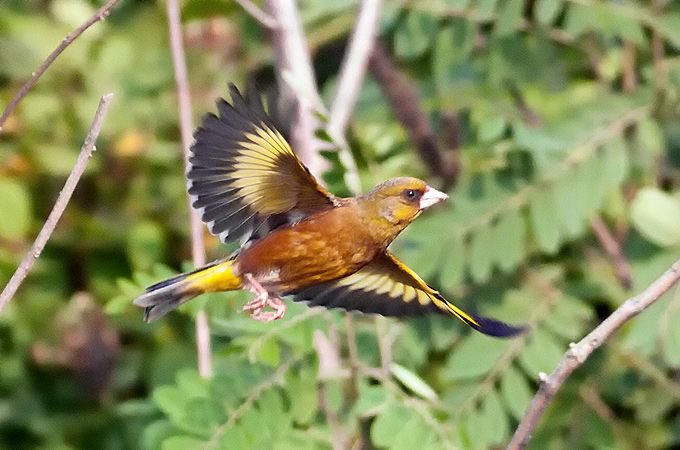
Goeje, June 14
Following the discovery of Black Woodpigeon on a small island off Geoje in early April by Birds Korean Mr. Matt Poll (many thanks!), a quick trip to the same island found 12 in all, with one sitting motionless in almost full view for 10 minutes providing the obvious highlight of the day. On the same island, a further 15 species of landbird were logged before survey had to be suspended due to strong winds. In order of abundance these were:
Vinous-throated Parrotbill (46), Japanese White-eye (44), Pale Thrush (42), Brown-eared Bulbul (38), Japanese Bush Warbler (17 heard – only one of which was seen), Pacific Swift (9), Eurasian Magpie (9), Large-billed Crow (8), Rufous Turtle Dove (6), Japanese Pygmy Woodpecker (4), Coal Tit (2), Asian Stubtail (two in song), Styan’s Grasshopper Warbler (two: one in song, one calling) and single Black Kite and Common Cuckoo (1).
Comparison with other islands shows this to be a strikingly odd mix: personally, this was the first time to see either Vinous-throated Parrotbill or Japanese Pygmy Woodpecker on a proper island; the first time to see Black Woodpigeon sharing an island with numerous crows and magpies; and the first island with dense broad-leaved forest without either Eastern Great Tit or Varied Tit…
Aham-do, June 10
Briefly again at Aham-do, there was also present a wing- injured Great Knot, which appears to be able to feed but sadly not fly. This is the only June record that I know of.

Han-River, June 9
At an Island in the Han River I at last had good views of a pair of Ruddy Kingfisher, who trilled to eachother occasionally or dropped to the forest floor after prey. I had previously glimpsed one at Sincheorwon, heard them at Gunsan, Shiripdae and Namhansan, but never seen them so well as today.
Other spectacularly colorful semi-tropical summer visitors in the vicinity included pairs or families of Yellow-rumped Flycatchers, Eurasian Nuthatch, Black-naped Oriole, and Broad-billed Roller. It was interesting to note the relative abundance of birds and insects in an area known to be historically free of pesticides.
Also noteworthy was a reddish-coloured Red Squirrel S.v. mantchurica. The vast majority in this country have blackish coats, and this is only the second red-coloured individual I have noticed – out of presumably hundreds that I have seen over the years.


Gimhae, June 8-9
Last week I was tipped off about an area within Gimhae that might be good habitat for forest birds – near the Gaya Country Club. I decided to have a gander. Southwest past the golf course, there is a narrow trail into the forest. There were no hikers – and perhaps it is private land. Species observed were Pygmy Woodpecker, White-backed Woodpecker, and Grey-headed Woodpecker towards to base of the trail (which ascends to the peak and ridge), Varied Tit, Coal Tit, Long-tailed Tit, and Eastern Great Tits throughout the forest. At about midway up Blue and White Flycatchers could be heard singing and observed close to the trail. There were several pairs and they were very vocal. Common Cuckoo, Oriental Cuckoo, and Lesser Cuckoo could also be heard. On the way up trail, I was mobbed by a large group of tits. I stood quietly and just observed. There must have been at least a couple dozen birds around me – mostly Varied and Eastern Great – some immature. Although some seemed curious, sadly, I felt unwelcomed. Towards the peak of the mountain, mostly Pale Thrushes could be heard singing.
Most interestingly was the song of a Fairy Pitta – not continuous, and only heard twice. It was heard in the afternoon of the 8th, and then again the next morning; also non-continuous and heard only twice. Asian Stubtail were also very vocal on the morning of the 9th, a Japanese Bush Warbler singing near the course, and Black-naped Oriole could be seen crossing over the canopy. I took photos of the different broad-leaved tree species – very excited to get to know this habitat a little better.
Goseong-Junam-Euguksa, June 7
A lovely day of birding began near a temple in the Goseong area. Two weeks earlier, Mr. Lee Ki Soo had observed a pair of Ruddy Kingfishers at the temple. We set out early to see if they were still present. As we began our morning walk, we carefully looked through the dense canopy of green leaves that followed the nearby creek water downstream. We first spotted an Oriental Dollarbird on a wire and then a few Eurasian Jays moving through the foliage. At a forest edge near a road side grave site, a Chinese Sparrowhawk sat high on a limb. A White-backed Woodpecker drummed away and a Pale Thrush flew by carrying a twig in its bill. The area seemed ‘birdy’ and several tits, thrushes, bulbuls were singing. Then with very much delight, at almost 8am, the beautiful song of two Ruddy Kingfishers could be heard from opposite sides of the forest. We walked up a nearby path, but didn’t stray far from the stream or temple. Suddenly an Oriental Scops Owl swooped by quickly, perhaps flushed by our approach. We sat quietly near the stream where the song was loudest and one of the kingfishers perched on a tree directly in front of us. My heart pounded for the few seconds we were able to observe it, and for the rest of the day, my smile seemed permanent.
Time passed quickly as we searched to get just one more view, but the kingfishers went silent at about half past eight. Mr. Lee mentioned that two weeks before, they had been most active at around 10am. As we waited, an Oriental Cuckoo started singing, some Black-naped Orioles started feeding actively, and the wind picked up a little. Two female Mandarin Ducks flew downstream. A closer look revealed a Chinese Sparrowhawk perched on a limb just over the flowing water. It flew downstream. At about ten, Lesser Cuckoos could be heard singing from the tops of trees and Asian Stubtails from within the shrubbery. A Grey-headed Woodpecker was also feeding. With no sign of Ruddy for a couple of hours, we decided to move on to Junam.
At Junam, there were a lot of Grey Herons and Great Egrets. There were also some Little Egrets, Intermediate Egrets, and Eastern Cattle Egrets. Oriental Reed Warblers were singing that summer was in the air. About 70-80 Little Terns were feeding on the reservoir, hovering and diving for fish. We hoped to see some Stilts on the rice fields, but there were none around.
At Dongpan, there were even larger numbers of Egrets and Herons, a flock of about 30 Spot-billed Ducks feeding, 2 male Mandarin Ducks, a Common Cuckoo on a wire, and a flock of White-cheeked Starlings feeding under the trees of a persimmon orchard.
At Euguksa (temple), we found Blue and White Flycatchers, one tending to a nest nearby a stoney patch of creek. We also found a Great Spotted Woodpecker. There were also many mosquitos, so we didn’t stay too long. On the way out, another Chinese Sparrowhawk flew by but then decided to have a bath. It was a hot afternoon but a great one for the start of the summer.
Aham-do, June 6
A visit to Aham-do found the Saunder’s Gull and Little Tern colony still active, however the birds are now having to fly several kilometres to reach mud to feed on due to relentless reclamation.
Also two or three Black-faced Spoonbill were here and a family of Eastern Oystercatcher with three chicks.
